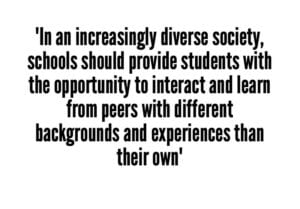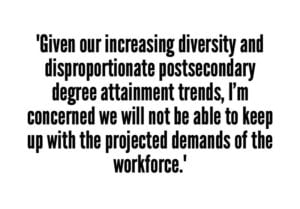Our nation is the most diverse it has ever been. According to population projections released by the Census Bureau, the United States will be a “majority minority” nation by 2044, with whites making up 49.7 percent of the population. But for our children under the age of 5, we are already there. In 2014, 50.2 percent of the 20 million children living in the U.S. were minorities. While our growing diversity should be welcomed and celebrated, we still have a long way to go in terms of ensuring all our young people have the opportunity to succeed in school, work, and life. Let’s examine some persistent trends currently impacting our students.
School Segregation
I’ve stated elsewhere that school integration benefits all students academically, occupationally, and socially, yet many students experience segregated schooling today. According to the UCLA Civil Rights Project, 74 percent of black students and 80 percent of Latino students attend majority nonwhite schools (50-100% non-white), and 38 percent of black students and 43 percent of Latino students attend “intensely segregated” schools (0-10% white). Moreover, black and Latino students are more likely to attend schools with nearly “double the share of low-income students” than white and Asian students.
 In an increasingly diverse society, schools should provide students with the opportunity to interact and learn from peers with different backgrounds and experiences than their own. Unfortunately, this mutually beneficial interaction is not a reality for many students.
In an increasingly diverse society, schools should provide students with the opportunity to interact and learn from peers with different backgrounds and experiences than their own. Unfortunately, this mutually beneficial interaction is not a reality for many students.
Achievement Gaps
According to the Nation’s Report Card, data from the National Assessment of Educational Progress (NAEP) revealed that achievement gaps have remained stagnant between 2009 and 2013, with white and Asian students scoring between 20-30 points higher on average in reading and math than black, Hispanic, and Native American students. However, the gap in reading scores between black and white students has significantly widened from 24 points in 1992 to 30 points in 2013. Additionally, while high school graduation rates reached an all-time high in 2013 at 81 percent and graduation gaps between student subgroups are narrowing, white and Asian students continue to graduate at much higher rates than black, Hispanic, and Native American students.
I’ve stated previously that not all schools are created equal, and as we continue to become a more diverse society and if achievement gaps persist, I worry about the implications of an education system unable to serve the majority of its students properly.
Disproportionate Degree Attainment
 Data compiled by the Pew Research Center reveals that total college enrollment has increased dramatically from 8.6 million in 1992 to 12.5 million in 2013. However, more recent data from the National Student Clearinghouse Research Center shows that college enrollment has declined for the fourth straight year in a row. This is likely because postsecondary enrollment of white students has deceased in recent years, while enrollment of non-white students has steadily increased over the last several decades. While these data show substantial gains in college access, black and Hispanic students continue to lag behind their white and Asian peers in terms of college completion. According to Pew, in 2012, white students accounted for 58 percent of college enrollees and 69 percent of bachelor degree holders, and Asian students accounted for 7 percent of enrollees and 11 percent degree holders. By contrast, in the same year, black students made up 14 percent of college enrollees and only 9 percent of bachelor degree holders, and Hispanic students made up 19 percent of enrollees and also only 9 percent of degree holders.
Data compiled by the Pew Research Center reveals that total college enrollment has increased dramatically from 8.6 million in 1992 to 12.5 million in 2013. However, more recent data from the National Student Clearinghouse Research Center shows that college enrollment has declined for the fourth straight year in a row. This is likely because postsecondary enrollment of white students has deceased in recent years, while enrollment of non-white students has steadily increased over the last several decades. While these data show substantial gains in college access, black and Hispanic students continue to lag behind their white and Asian peers in terms of college completion. According to Pew, in 2012, white students accounted for 58 percent of college enrollees and 69 percent of bachelor degree holders, and Asian students accounted for 7 percent of enrollees and 11 percent degree holders. By contrast, in the same year, black students made up 14 percent of college enrollees and only 9 percent of bachelor degree holders, and Hispanic students made up 19 percent of enrollees and also only 9 percent of degree holders.
By 2020, 65 percent of all jobs will require some form of postsecondary education or training. Given our increasing diversity and disproportionate postsecondary degree attainment trends, I’m concerned we will not be able to keep up with the projected demands of the workforce.
This post only scratches the surface of some of the educational inequities our students face. As the percentage of white students continues to shrink and the percentage of students of color continues to grow, how will we respond to these shifting demographics? What will we do about these inequities? And when will we ensure all our young people have the tools to succeed in school, work, and beyond?
Jenna Tomasello is a Program Associate at the American Youth Policy Forum.





